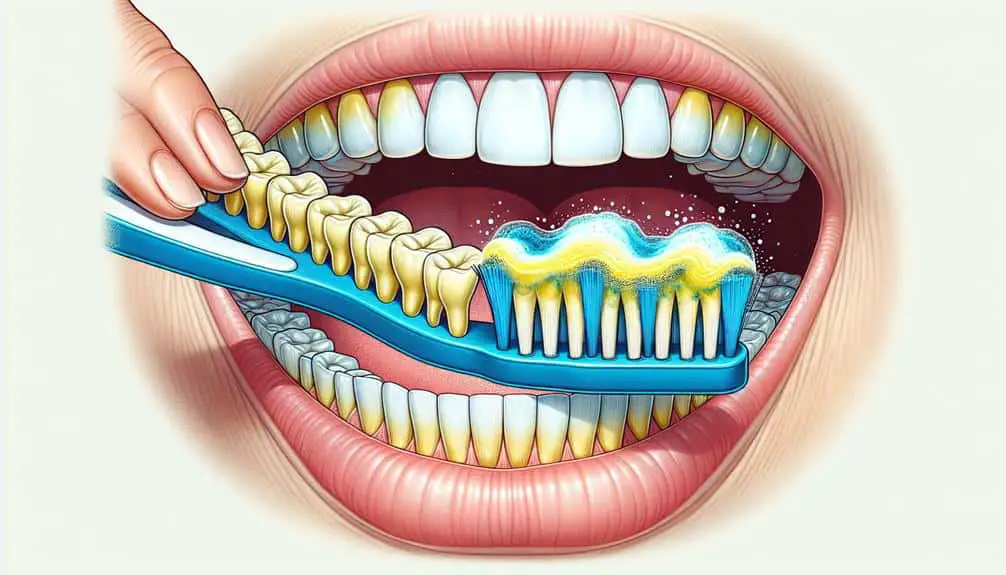To remove fluoride stains, try these methods: Lemon juice and baking soda. Make a paste and brush it onto stained teeth. Activated charcoal paste absorbs impurities. Mix with water and apply once a week. Oil pulling with coconut oil helps combat bacteria. Swish for 15-20 minutes. Turmeric and coconut oil paste reduce discoloration. Create a paste and incorporate into your routine. Strawberries and baking soda blend break down surface stains. Use mashed strawberries and baking soda. Maintain oral hygiene for lasting results. These natural remedies can help restore your dental health and the brightness of your smile.
Key Points
- Lemon juice and baking soda paste for gentle scrubbing and bleaching of fluoride stains.
- Activated charcoal paste absorbs toxins and removes stains effectively.
- Oil pulling with coconut oil aids in toxin removal and reduces plaque buildup.
- Turmeric and coconut oil paste combat discoloration with antibacterial properties.
- Blend of strawberries and baking soda breaks down stains for improved dental health.
Lemon Juice and Baking Soda
To effectively remove fluoride stains, start by creating a paste using a mixture of lemon juice and baking soda. Citrus remedies, like lemon juice, contain natural bleaching properties that can help diminish stains on your teeth. Baking soda, known for its mild abrasiveness, aids in scrubbing away surface stains without being too harsh on your enamel. When combined, these natural alternatives form a gentle yet effective solution for combating fluoride stains.
To make the paste, squeeze out fresh lemon juice and mix it with baking soda until you achieve a thick consistency. You can adjust the amounts to create a paste that's easy to apply on your teeth. Once you have the paste ready, use a toothbrush to gently brush it onto your teeth, focusing on the areas affected by fluoride stains. Allow the paste to sit on your teeth for a couple of minutes before rinsing thoroughly. Repeat this process regularly to see improvements in reducing fluoride stains and brightening your smile naturally.
Activated Charcoal Paste
For effectively combating fluoride stains, consider utilizing an activated charcoal paste as a natural remedy. Activated charcoal is known for its dental benefits and its ability to effectively remove stains from the surface of teeth. When used as a paste, activated charcoal can absorb the toxins and impurities that cause fluoride stains, leaving your teeth looking brighter and cleaner.
To create an activated charcoal paste at home, mix a small amount of activated charcoal powder with a few drops of water to form a thick paste. Gently brush this paste onto your teeth, focusing on the areas affected by fluoride stains. Allow the paste to sit on your teeth for a few minutes before rinsing thoroughly. For best results, use this treatment once a week.
Activated charcoal is a gentle yet effective option for those looking to remove fluoride stains naturally. Its dental benefits extend beyond stain removal, as it can also help freshen breath and promote overall oral health.
Oil Pulling With Coconut Oil
Consider incorporating oil pulling with coconut oil into your oral care routine as a natural method to address fluoride stains on your teeth. Oil pulling involves swishing coconut oil around in your mouth for about 15-20 minutes, allowing the oil to pull out toxins, bacteria, and stains from your teeth and gums. This ancient Ayurvedic practice is known for its oral hygiene benefits and can help improve overall oral health.
Coconut oil is rich in lauric acid, which has antimicrobial properties that can help combat bacteria in the mouth. By incorporating oil pulling into your routine, you may experience fresher breath, reduced plaque buildup, and a healthier mouth. Additionally, the gentle abrasive action of the oil can help remove surface stains, including those caused by fluoride.
Regular oil pulling with coconut oil can contribute to maintaining good oral hygiene and potentially aid in reducing fluoride stains over time. It's a simple and cost-effective method that offers various health benefits beyond just addressing stains on your teeth.
Turmeric and Coconut Oil Paste
Are you looking for a natural solution to tackle fluoride stains on your teeth effectively? A mixture of turmeric and coconut oil can be a beneficial paste to contemplate incorporating into your oral care routine.
Turmeric, a spice known for its vibrant yellow color and numerous health benefits, contains curcumin, a compound with anti-inflammatory and antioxidant properties. These properties may help combat the discoloration caused by fluoride stains on the teeth. Additionally, turmeric is believed to have antimicrobial properties that could contribute to overall oral health.
Coconut oil, on the other hand, is lauded for its antibacterial and anti-inflammatory properties. When combined with turmeric, coconut oil can act as a natural toothpaste alternative that may assist in removing fluoride stains. The gentle abrasiveness of turmeric coupled with the cleansing properties of coconut oil make this paste a promising option for those seeking a more natural approach to oral care.
Consider incorporating this turmeric and coconut oil paste into your dental hygiene routine for potential benefits beyond just stain removal.
Strawberries and Baking Soda Blend
To effectively address fluoride stains on your teeth, consider utilizing a blend of strawberries and baking soda. Strawberries are rich in fruit acids that can help break down surface stains on the teeth. When combined with baking soda, which acts as a natural abrasive, this mixture can aid in gently scrubbing away the discoloration caused by fluoride.
The fruit acids in strawberries work to remove stains by breaking down the compounds that bind them to the enamel. Baking soda, on the other hand, provides a mild abrasive action that assists in physically scrubbing off the stains. Together, these two ingredients create a powerful yet natural remedy for combating fluoride stains.
To make the blend, mash up a ripe strawberry and mix it with a small amount of baking soda to form a paste. Gently brush this mixture onto your teeth, allowing it to sit for a few minutes before rinsing thoroughly. Remember that while this method can help reduce fluoride stains, maintaining good oral hygiene practices is crucial for long-term dental health.
Frequently Asked Questions
Are There Any Potential Side Effects or Risks Associated With Using These Natural Methods to Remove Fluoride Stains?
When using natural methods to remove fluoride stains, there may be potential risks such as irritation or allergic reactions. However, the benefits include avoiding harsh chemicals. Alternative treatments should be researched, and precautions like spot-testing are advised.
Can These Methods Be Used on All Types of Teeth, Including Sensitive Teeth or Dental Restorations?
Sensitive teeth or dental restorations may raise concerns, but natural methods for removing fluoride stains can be gentle. These techniques are adaptable to various tooth types, ensuring effective stain removal without causing discomfort or harm.
How Often Should These Treatments Be Done to See Noticeable Results in Removing Fluoride Stains?
To see noticeable results in removing fluoride stains, treatments should be done regularly. Consistent frequency of treatments is key for long term efficacy. Remember, the more diligent you are in keeping up with treatments, the better the results.
Are There Any Specific Dietary or Lifestyle Changes That Can Help Prevent Fluoride Stains From Forming in the First Place?
To prevent fluoride stains, focus on your dietary habits and lifestyle changes. Incorporate more water, calcium-rich foods, and limit sugary drinks. Brush regularly, and consider natural remedies like oil pulling. These preventative measures can help maintain a healthy smile.
Are There Any Professional Treatments or Procedures That Can Effectively Remove Fluoride Stains for Those Who Prefer a More Traditional Approach?
For those seeking a more traditional approach to dealing with fluoride stains, professional options like cosmetic dentistry offer alternative solutions. Home remedies may help, but cosmetic procedures can effectively remove stubborn fluoride stains.



